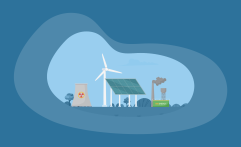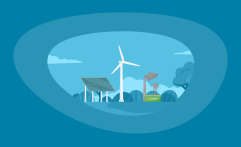19 Best Carbon Offsets (Complete 2024 List)
Impactful Ninja is reader-supported. When you buy through links on our site, we may earn an affiliate commission.
Learn more
Learn more
.
Hey fellow impactful ninja ? You may have noticed that Impactful Ninja is all about providing helpful information to make a positive impact on the world and society. And that we love to link back to where we found all the information for each of our posts. Most of these links are informational-based for you to check out their primary sources with one click. But some of these links are so-called "affiliate links" to products that we recommend. First and foremost, because we believe that they add value to you. For example, when we wrote a post about the environmental impact of long showers, we came across an EPA recommendation to use WaterSense showerheads. So we linked to where you can find them. Or, for many of our posts, we also link to our favorite books on that topic so that you can get a much more holistic overview than one single blog post could provide. And when there is an affiliate program for these products, we sign up for it. For example, as Amazon Associates, we earn from qualifying purchases. First, and most importantly, we still only recommend products that we believe add value for you. When you buy something through one of our affiliate links, we may earn a small commission - but at no additional costs to you. And when you buy something through a link that is not an affiliate link, we won’t receive any commission but we’ll still be happy to have helped you. When we find products that we believe add value to you and the seller has an affiliate program, we sign up for it. When you buy something through one of our affiliate links, we may earn a small commission (at no extra costs to you). And at this point in time, all money is reinvested in sharing the most helpful content with you. This includes all operating costs for running this site and the content creation itself. You may have noticed by the way Impactful Ninja is operated that money is not the driving factor behind it. It is a passion project of mine and I love to share helpful information with you to make a positive impact on the world and society. However, it's a project in that I invest a lot of time and also quite some money. Eventually, my dream is to one day turn this passion project into my full-time job and provide even more helpful information. But that's still a long time to go. Stay impactful,Affiliate Disclosure
Why do we add these product links?
What do these affiliate links mean for you?
What do these affiliate links mean for us?
What does this mean for me personally?
![]()
Carbon offsets could play a crucial role in mitigating climate change because they allow us to reduce carbon dioxide (CO2) emissions from activities where sustainable alternatives are not yet widely available. In today’s market, there is a wide range of offset types and countless companies offering carbon offset projects. So, we had to ask: What are the best carbon offsets?
The best carbon offsets include technology-based solutions like Climeworks, Neustark, DelAgua, and CoreZero; and nature-based solutions like The Arbor Day Foundation, REDD.plus, SeaTrees, and Husk.
Keep reading to learn more about the best carbon offsets, how these carbon offset projects work, what their respective offsetting costs are, and what your best way would be to offset your carbon emissions. At the end of the article, we’ll also share with you what the biggest carbon offsetting limitations are and why reducing your carbon footprint is more effective than offsetting it.
Here’s What All the Best Carbon Offsets Have in Common
We already have governmental-level policies in place to reduce greenhouse gas emissions (GHGs), but how do we reduce emissions from activities where sustainable alternatives are not yet widely available? The answer just might be carbon offsets.
When you hear the words “carbon offset”, think about the term “compensation”. Essentially, carbon offsets are reductions in GHG emissions that are used to compensate for emissions occurring elsewhere.
“Carbon Offset: a way for a company or person to reduce the level of carbon dioxide for which they are responsible by paying money to a company that works to reduce the total amount produced in the world, for example by planting trees”
Oxford Dictionary
Carbon offsets are measured in tons of carbon dioxide equivalents and are bought and sold through international brokers, online retailers, and trading platforms.
Carbon offsets can be split into 2 categories, technology-based and nature-based carbon offsets.
- Technology-based carbon offsets are those that use specialized technology to extract carbon from the atmosphere so that it can then be repurposed or stored permanently in various reservoirs. These include direct carbon/air capture, carbon mineralization, energy efficiency, waste management, and some agricultural offsets.
- Nature-based carbon offsets are those that focus on the long-term storage of captured or removed carbon in plants, soils, and the ocean, which are capable of absorbing massive amounts of our greenhouse gas (GHG) emissions. These include reforestation, afforestation, REDD+, blue carbon, and some agricultural offsets.
Carbon offsets also play a crucial role in reducing our carbon footprint, the amount of CO2 emissions associated with an individual or an entity. The carbon footprint is one of the ways we measure the effects of human-induced global climate change. It primarily focuses on the greenhouse gas emissions associated with consumption, but also includes other emissions such as methane, nitrous oxide, and chlorofluorocarbons.
These Are the 19 Best Carbon Offsets in 2024
Below are our favorite carbon offsets (you can click on their link to directly jump to their section in this article):
| Carbon Offsets | Quick Facts |
| Climeworks | About: Carbon offset purchases support the practice of direct CO2 removal, where specialized machines remove CO2 directly from the air and store it in rock formations underground. Costs: $1,200 per 1,000kg of CO2 |
| Neustark | About: Neustark removes CO2 from the atmosphere and stores it in recycled concrete, and they cut new CO2 emissions by reducing the use of traditional cement. Costs: Costs are determined after initial contact. |
| The Arbor Day Foundation | About: Carbon offset purchases support afforestation (and reforestation) projects in the Mississippi Alluvial Valley (US), Nicaragua, and Peru. Costs: $40 per 1,000kg of CO2 |
| REDD.plus | About: Carbon offset purchases support UNFCCC-verified REDD+ projects around the globe. REDD.plus is a central registry and exchange for REDD+ Result Units, a type of carbon credit. Costs: $16 per ton of CO2 |
| SeaTrees | About: Carbon offset purchases support coral reef/kelp forest/watershed restoration and mangrove tree planting. Costs: $22 per 1,000kg of CO2 |
| DelAgua | About: Purchases support the Rwandan clean cookstoves energy-efficiency carbon offset project. Costs: Costs are determined after initial contact |
| CoreZero | About: Purchases support waste management projects including food rescue, upcycling, waste-to-energy, and composting. Costs: Costs are determined after initial contact |
| Husk | About: Husk converts rice husks into biochar, fertilizers, and biopesticides via smokeless pyrolysis, preventing the re-emission of carbon into the atmosphere. Costs: Husk uses resellers to sell its solutions. Visit Patch’s website to learn more about pricing. |
| greenSand | About: greenSand uses Olivine rocks, which trap CO2 when they come into contact with water. For every ton of CO2 purchased, greenSand spreads 1 ton of Olivine, which can in turn absorb and permanently store 1 ton of CO2. Costs: $82 per 1,000kg of CO2 |
| Ecologi | About: Carbon offset purchases support third-party certified reforestation carbon offset projects including those in Madagascar, Mozambique, Bolivia, and Morocco. Costs: $6.04 per 1,000 kg of CO2 offset |
| One Tree Planted | About: Carbon offset purchases support reforestation/afforestation projects including those in the US, Romania, Iceland, and Africa. Costs: $20 per 1,000kg of CO2 |
| Wildlife Works | About: Carbon offset purchases support third-party certified carbon offset projects including The Kasigau Corridor, Mai Ndombe, and Southern Cardamom REDD+ projects in Kenya, Cambodia, and Colombia respectively. Costs: $20 per ton of CO2 |
| The Ocean Foundation | About: Carbon offset purchases support the SeaGrass Grow, seagrass planting project. Costs: $20 per 1,000kg of CO2 |
| South Pole | About: Purchases support energy-efficiency carbon offset projects including clean cookstoves in China, Mali, and Rwanda. Costs: Costs are determined after initial contact |
| GreenTech | About: They take plastic (e.g., plastic bottles) and sort, grind, wash, and process it into sustainable recycled flakes to make products (e.g., PET flakes, PET straps, and r-PET granules). Costs: $40 per 1,000kg of CO2 |
| Vi Agroforestry | About: Vi Agroforestry specializes in poverty reduction and environmental improvement through agroforestry and improved farming practices. Costs: $28 per 1,000kg of CO2 offset |
| Carbofex | About: Carbofex’s pyrolysis technology takes waste biomass from urban or agricultural sources and turns it into biochar, which can then be used to enhance agricultural soils or to produce renewable energy. Costs: Carbofex uses resellers to sell its solutions. Visit the Puro.earth website to learn more about their respective pricing. |
| Carbonfund | About: Purchases support reforestation, energy efficiency, and waste management projects. Costs: $16.25-$17.16 per 1,000kg of CO2 for individuals, $390-$1,560 per year for small businesses, determined after initial contact for large businesses |
| Terrapass | About: Carbon offset purchases support reforestation, afforestation, REDD+, blue carbon, waste management, and agricultural projects. Costs: $16.51-$17.63 per 1,000kg of CO2 |
Climeworks: The Leader in Direct CO2 Removal
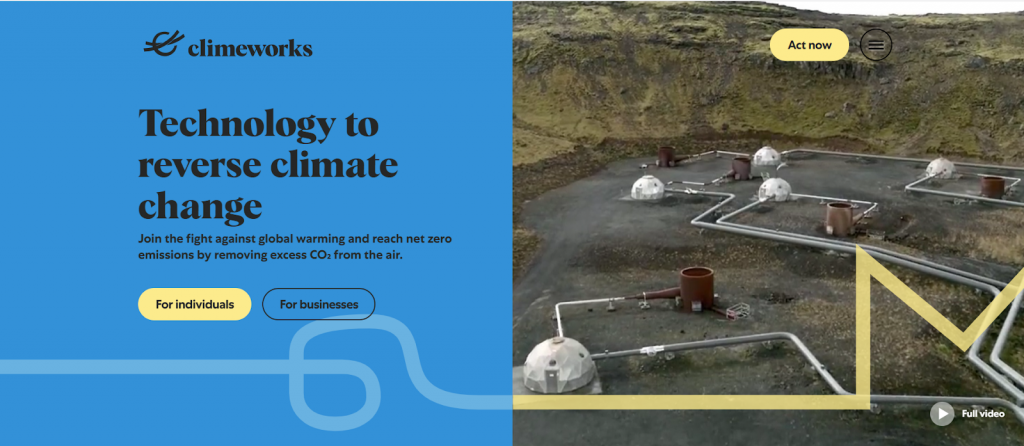
Climeworks is a Swiss direct air capture (DAC) company founded in 2009 by engineering university students Jan and Christoph, who were both shocked at the melting glaciers in the Swiss Alps. Today, their mission is to inspire one billion people to remove CO2 from the air and reverse climate change.
“Let’s reverse climate change”
Climeworks
Project overview: Climeworks’ process can be divided into two parts: carbon capture and carbon storage. Climeworks has specialized machines that first capture CO2 from the air. They then partnered with Icelandic company Carbfix to turn the captured CO2 into stone in less than two years. Carbfix dissolves the captured CO2 in water and injects it underground where it reacts with basalt rock to form solid minerals via natural processes. To date, they have injected over 70,000 tons of CO2 at their Icelandic site.
Carbon offset effectiveness: Climeworks offsets are permanent, measurable, and effective. Carbfix’s process is based on scientific research and has been proven successful at an industrial scale.
Carbon offset costs: Climeworks offers monthly, one-off, or gift carbon purchase options at a cost of $1.20 per 1 kilogram (kg) of CO2 removed.
How to get your carbon offsets: You can get your carbon offsets directly from Climework’s webshop, where you can also select how much CO2 you want to remove along with your preferred frequency (monthly, one-off, or gift).
Neustark: Locking Away CO2 in Concrete
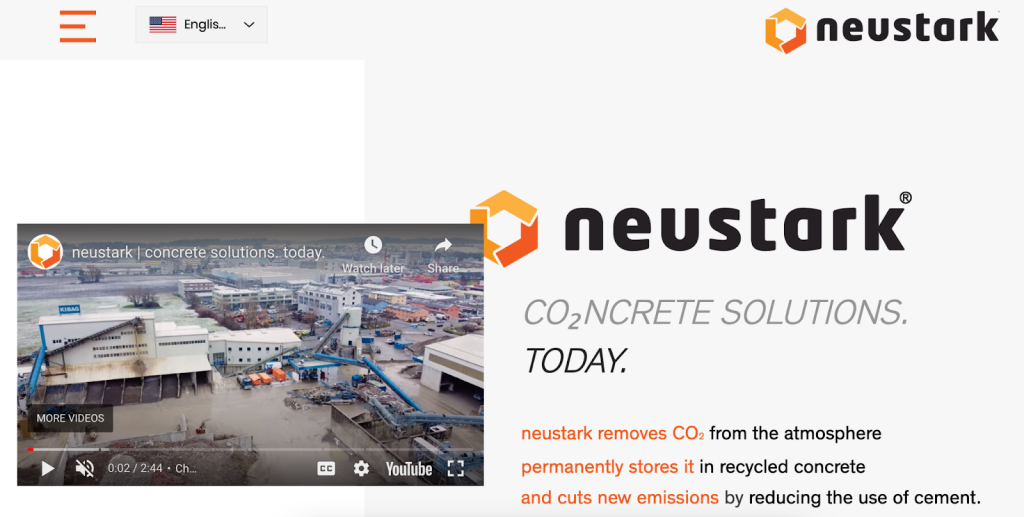
Neustark was founded in 2019 by Johannes Tiefenthaler and Valentin Gutknecht on the shared vision of a solution for the utilization and storage of CO2. Today they have developed technology that produces one of the most climate-friendly concrete. Their mission is to reduce the global construction industry’s carbon footprint by 1 billion tons of CO2 per year by 2050.
“Co2ncrete Solutions. Today.”
Neustark
Project overview: Neustark removes CO2 from the atmosphere and permanently stores it in recycled concrete via the process of mineralization, what they call their ‘Carbon Dioxide Removal (CDR) service’. Approximately 10kg of CO2 are stored per cubic meter of concrete, and up to 20kg of CO2 emissions are avoided in the concrete production process. This results in a carbon removal efficiency of 95%.
Carbon offset effectiveness: Neustark’s carbon credits are permanent, safe, and only issued for net carbon removal. Their process is also credited by the Gold Standard.
Carbon offset costs: Costs are determined after initial contact.
How to get your carbon offsets: You can contact a Neustark representative to get your carbon offsets.
The Arbor Day Foundation: Inspiring People to Plant, Nurture, and Celebrate Trees
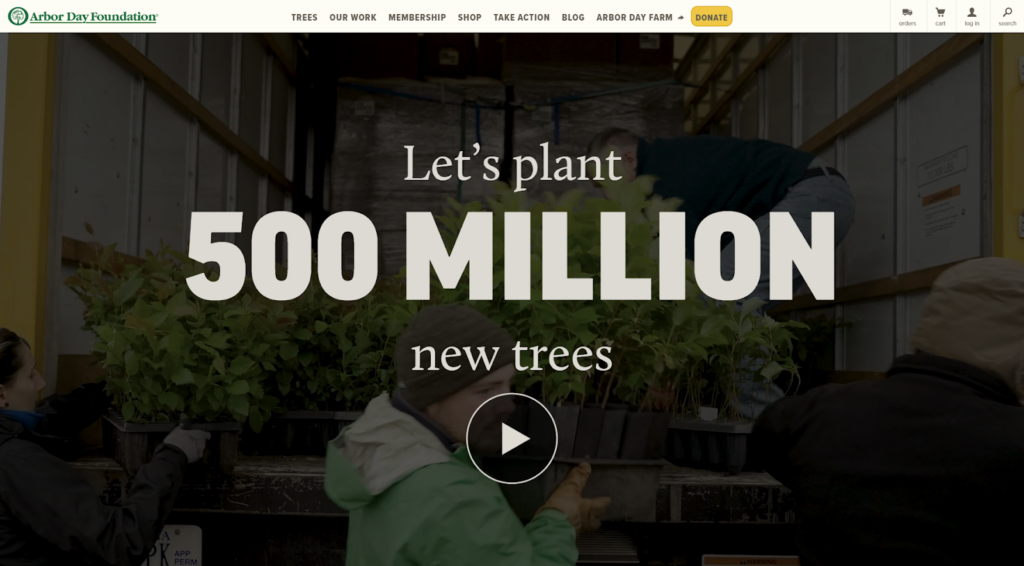
The Arbor Day Foundation was founded in 1972 by John Rosenow to commemorate the 100-year anniversary of Arbor Day, the oldest environmental holiday. Today, they are a nonprofit that has expanded to 55 countries and has planted over 500 million trees. They aim to both plant trees and help people understand their value.
“Let’s grow a movement”
The Arbor Day Foundation
Carbon offset overview: The Arbor Day Foundation has partnered with GreenTrees®, Taking Root, and Ecotierra to support reforestation/afforestation projects in the Mississippi Alluvial Valley (US), Nicaragua, and Peru, respectively. These projects restore degraded agricultural lands, replenish soils, and resort forest canopy.
Carbon offset effectiveness: The Mississippi, Nicaragua, and Peru offset projects are certified according to the American Carbon Registry, Plan Vivo, and the Verified Carbon Standard, respectively. The Arbor Day Foundation’s offset projects also adhere to one or more of the UN’s Sustainable Development Goals.
Carbon offset costs: It costs $40 per 1,000kg of CO2 offset.
How to get your carbon offsets: You can visit Arbor Day’s website to purchase your carbon offsets.
REDD.plus: A Central Registry and Exchange for REDD+ Result Units
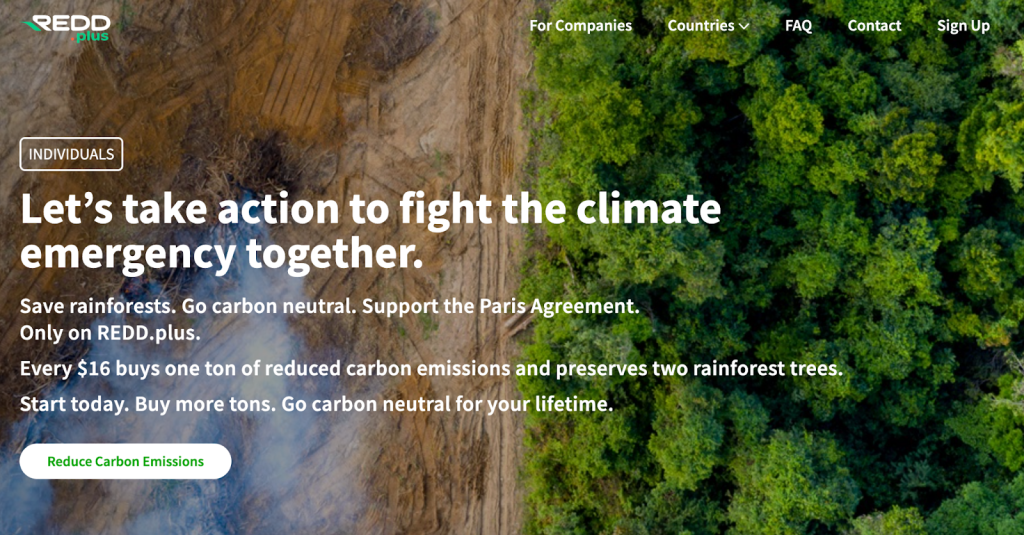
REDD.plus was founded by the Coalition for Rainforest Nations to give individuals and businesses the ability to purchase carbon emissions reductions generated by verified REDD+ projects. Today, they manage the creation of and platform on which REDD+ carbon credits are sold in order to reduce deforestation and prevent further degradation.
“Let’s take action to fight the climate emergency together”
REDD.plus
Project overview: REDD.plus is a project of the Coalition for Rainforest Nations, which consists of over 50 rainforest nations. The basis of REDD.plus is the REDD+ Result Unit (RRU), which is a type of carbon credit. A country’s national government develops a REDD+ strategy, the results of which are independently verified and published on a central hub. Serialized RRUs can then be purchased on the REDD.plus platform or CBL markets. Every RRU purchased saves 2 rainforest trees, and over 90% of your purchase goes back to the countries and local communities that are protecting rainforests around the world.
Carbon offset effectiveness: A country’s national government issues each RRU to prevent leakage and double-counting, REDD+ results are independently verified and published on the UNFCCC Info Hub, and each RRU is retired once it has been sold.
Carbon offset costs: Each RRU costs $16 and offsets 1 ton of CO2 emissions. RRUs are available for purchase as a one-time or monthly purchase.
How to get your carbon offsets: You can visit the REDD.plus website to purchase your RRUs.
SeaTrees: Regenerating Blue Carbon Coastal Ecosystems
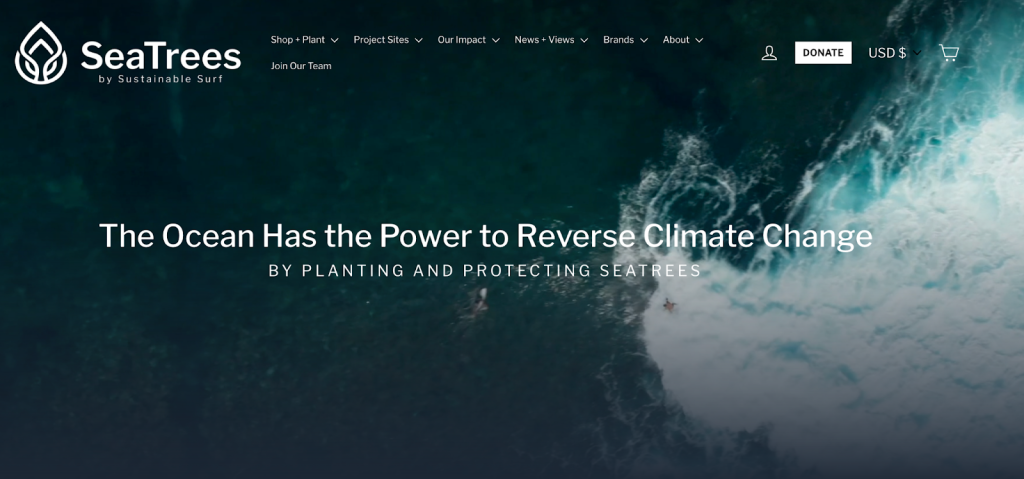
SeaTrees was founded in 2018 as a program of the non-profit organization Sustainable Surf to plant, protect, and restore blue carbon coastal ecosystems. Today, they have 16 active projects worldwide involving mangrove planting, kelp/seagrass/coral reef restoration, and watershed protection.
“We can come together + act now to restore coastal ecosystems.”
SeaTrees
Carbon offset overview: SeaTrees is a nonprofit environmental organization that restores coral reefs, plants mangrove trees, restores kelp forests, and restores watersheds in the US, Indonesia, and Kenya. Their custom blended carbon offset product, the SeaTrees Token, combines carbon credits with innovative blue carbon projects. Each SeaTrees Token purchased sequesters 1 ton of CO2 via Verified Carbon Standard certified offset projects, plants 4 mangrove trees, and creates 1 square foot of kelp forest.
Carbon offset effectiveness: SeaTrees projects are verified according to the Verified Carbon Standard and contribute to multiple UN Sustainable Development Goals. Two of their planting partners also include Eden Reforestation Projects, which is included in our list of the Best Charities for Reforestation, and Wildlife Works, which is included in our list of the Best REDD+ Carbon Offsets.
Carbon offset costs: It costs $22 per 1,000kg of CO2 offset.
How to get your carbon offsets: You can visit their website to purchase your blue carbon offsets.
DelAgua: Experts in Carbon Development Projects
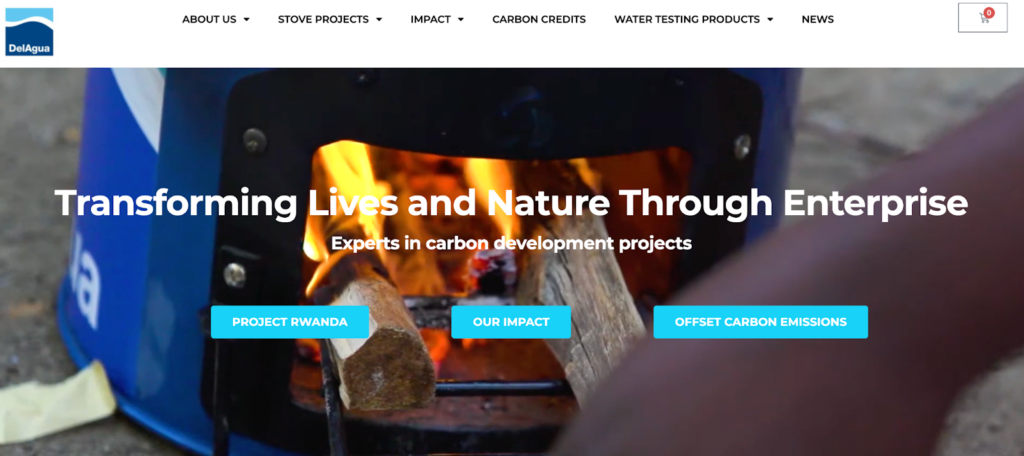
DelAgua was founded in 1985 as a water testing company aimed at providing clean water to rural African communities. Today, their water testing kit is used in 150+ countries and they offer carbon credits from a pioneer Rwandan clean cookstoves project.
“Transforming lives and nature through enterprise”
DelAgua
Carbon offset overview: DelAgua launched the Rwandan clean cookstoves project in partnership with the Government of Rwanda in 2013 to transform the lives and environment of rural African communities. To date, the project has provided over 6 million Rwandans with 1.3 million stoves, free of charge. The stoves use small twigs and branches, which people can collect without cutting down trees, thereby reducing deforestation and using 71% less wood than a traditional fire. It is one of the largest programs of its kind which has helped pull families from poverty and avoid CO2 emissions.
Carbon offset effectiveness: Del Agua’s carbon offset projects are certified by the Verified Carbon Standard. They are also aligned with the Paris Agreement and adhere to multiple UN Sustainable Development Goals.
Carbon offset costs: Costs are determined after initial contact.
How to get your carbon offsets: You can visit DelAgua’s website and contact a representative to get your energy-efficiency carbon offsets.
CoreZero: Food Rescue and Upcycling
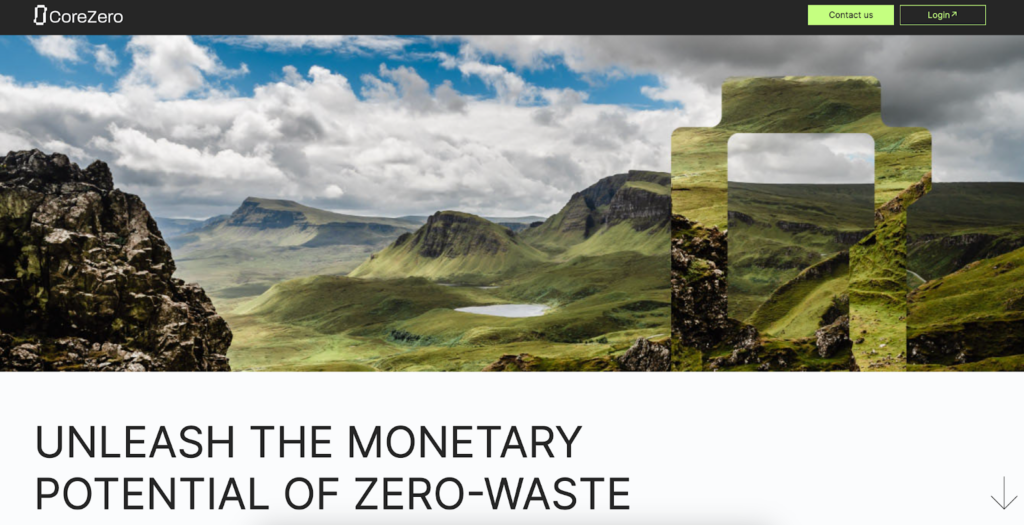
CoreZero was founded in 2020 by Jean Pierre Azañedo and Ignacio Bordigoni as a way to reduce global waste and methane (CH4) emissions. Today, they monetize food rescue, upcycling, waste-to-energy, and composting projects through carbon credits.
“Unleash the monetary potential of zero-waste.”
CoreZero
Carbon offset overview: CoreZero generates carbon credits in a few different ways, including via food banks, upcycling, composting, and wastewater treatment plants. They work directly with food banks to rescue food before it can become waste. They also create carbon credits based on the environmental impact of wastewater treatment plants, which can encourage organizations to invest more in the technology.
Carbon offset effectiveness: CoreZero’s offsets are verified by an independent third party and, depending on the specific offset, are certified by either the Verified Carbon Standard, Gold Standard, American Carbon Registry, or the Global Carbon Council.
Carbon offset costs: Costs are determined after initial contact.
How to get your carbon offsets: You can visit CoreZero’s website and contact a representative to get your carbon offsets.
Husk: Biochar-Based Fertilizers
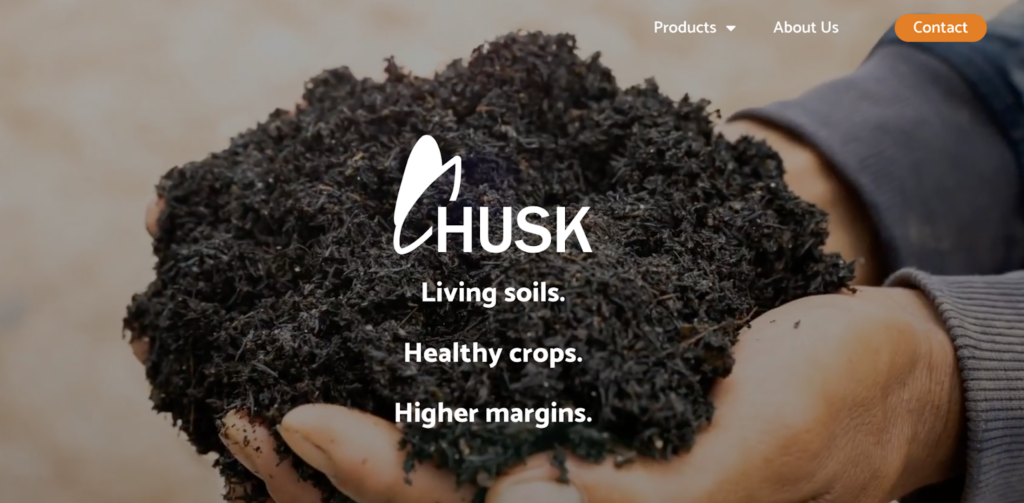
Husk was founded in 2017 by Heloise Buckland and Carol Rius based on the idea that the private sector can combat social inequality and tackle climate change. To date, they have sequestered over 750 tons of carbon on their mission to create a world with living soils, healthy crops, fair wages, and climate justice.
“Living soils. Healthy crops. Higher margins”
Husk
Project overview: Husk converts rice husks into biochar, fertilizers, and biopesticides via smokeless pyrolysis, preventing the re-emission of carbon into the atmosphere. When biochar-based fertilizers are spread on crops, the sequestered carbon within the products is buried into the soil where it will remain for hundreds of years. The process generates carbon credits that are sold to individuals and businesses looking to lower their carbon footprint.
Carbon offset effectiveness: Husk’s biochar plant follows European Biochar Certification (EBC C-Sink) standards, one of the highest standards for carbon removal.
Carbon offset costs: Husk uses resellers to sell their solutions. Visit Patch’s website to learn more about pricing.
How to get your carbon offsets: You can get your Husk biochar carbon offsets through the Patch website.
greenSand: Olivine – The Great CO2 Cleaner

greenSand was founded in 2009 by Eddy Wijnker after he realized that Olivine, a mineral, had the potential to clean up CO2. Today, they offer carbon offsets for individuals and businesses and have developed products of olivine-rich rocks that can replace current sand and stone applications. Their mission is to permanently clean up extra CO2 to bring balance back into the Earth’s CO2 cycle.
“We save the earth with stones and sand, will you help?”
greenSand
Project overview: greenSand uses Olivine rocks, which trap CO2 when they come into contact with water. The carbon stored in Olivine rocks is stored permanently, and it is only released if the temperature exceeds 1,600 degrees. For every ton of CO2 purchased, greenSand spreads 1 ton of Olivine, which can in turn absorb 1 ton of CO2.
Carbon offset effectiveness: greenSand is Open Natural Carbon Removal Accounting (ONCRA) certified. ONCRA is a framework for measuring the removal and storage of CO2 via nature-based solutions.
Carbon offset costs: greenSand’s offsets cost $82 per 1,000kg of CO2 offset.
How to get your carbon offsets: You can visit greenSand’s website to get your carbon offsets.
Ecologi: Where Carbon Reduction Partners with Reforestation/Afforestation
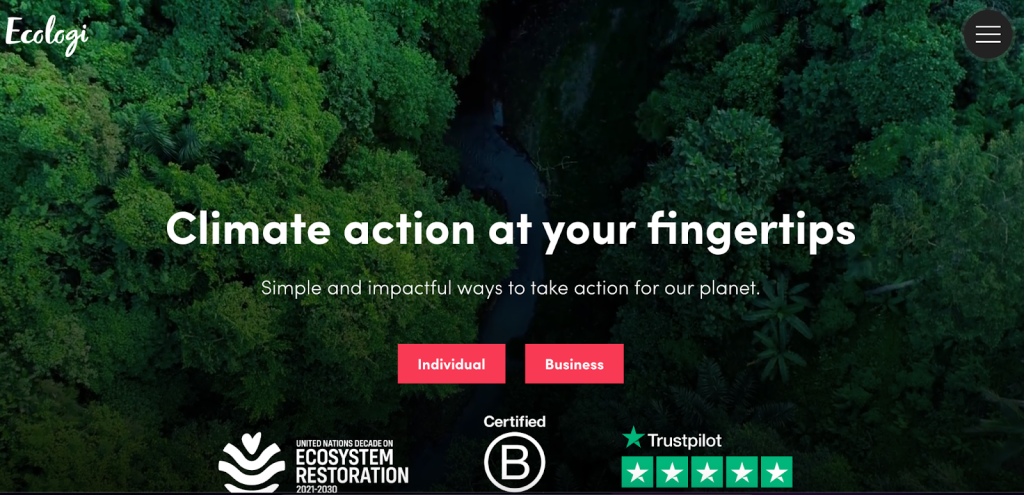
Ecologi was founded in 2019 by Elliot Coad, Lucy Jack, and Alex Price as an answer to the question “What if I put the money from my morning coffee into climate action”? Today, they have funded over 57 million trees, avoided over 2 million tons of carbon, and continue to enable everyday people to tackle the current climate crisis via reforestation and carbon offsetting projects.
“For less than the cost of a cup of coffee per week, you can become climate-positive.”
Ecologi
Project overview: When you purchase carbon offsets through Ecologi, trees are planted as a bonus, because it takes years for trees to mature and sequester carbon in large quantities.
Examples of reforestation projects include mangrove planting in Madagascar, reforestation in Mozambique, protecting and restoring Andean forests in Bolivia, and saving endemic fruit tree species in Morocco. Examples of afforestation projects include Restoring Degraded Land in Senegal and Forest Plantation on Degraded Grassland in Uruguay.
Carbon offset effectiveness: Ecologi’s reforestation/afforestation projects are certified by either the Gold Standard or the Verified Carbon Standard. Their reforestation/afforestation partners include Eden Reforestation Projects, One Tree Planted, and Trees for the Future, all of which are included in our list of the Best Charities for Reforestation.
Carbon offset costs: It costs approximately $6.04 per 1,000 kg of CO2 offset. Ecologi has a personal offset plan where you choose how many trees get planted (12, 24, or 48) for a price ($10.50, $21, or $42 per month). And if you scroll further down, you can plant 1 extra tree in the US for only $1.20 per month.
How to get your carbon offsets: You can visit Ecologi’s website to select your personal carbon offset plan and get your reforestation carbon offsets.
One Tree Planted: A Non-Profit Focused On Global Reforestation/Afforestation
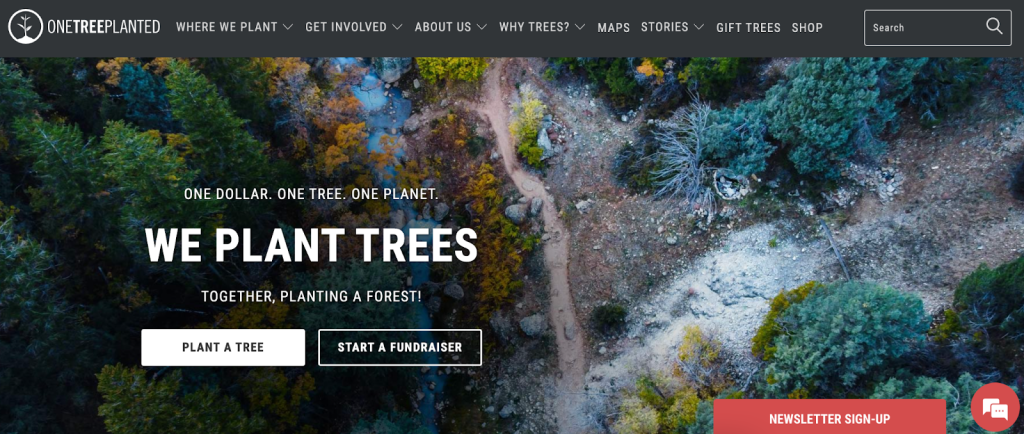
One Tree Planted was founded in 2014 by Matt Hill as a way to make it easier for individuals and businesses to aid in environmental conservation and reforestation across the globe. Today, they have planted over 100 million trees in more than 47 countries.
“One dollar. One tree. One planet.”
One Tree Planted
Carbon offset overview: One Tree Planted is a nonprofit environmental organization that plants trees in North America, Latin America, Africa, Asia, Europe, and the Pacific. Example reforestation offset projects include reforestation in areas affected by wildfires in California and restoring native flora in Romania. An example afforestation offset project includes afforestation in Iceland, which aims to reforest a 150-hectare area previously degraded by overgrazing. One of their more ambitious projects is AFR100, which aims to restore 100 million hectares of deforested & degraded land in Africa.
Carbon offset effectiveness: One Tree Planted’s offsets are certified by the Climate Action Reserve and are retired on a monthly basis.
Carbon offset costs: One Tree Planted offers 3 offset options that offset 10, 20, and 30 tonnes of CO2 at a cost of $20 per 1,000kg of CO2.
How to get your carbon offsets: You can visit their website to view their plans and purchase your carbon offsets.
Wildlife Works: A Market-Based Conservation Model
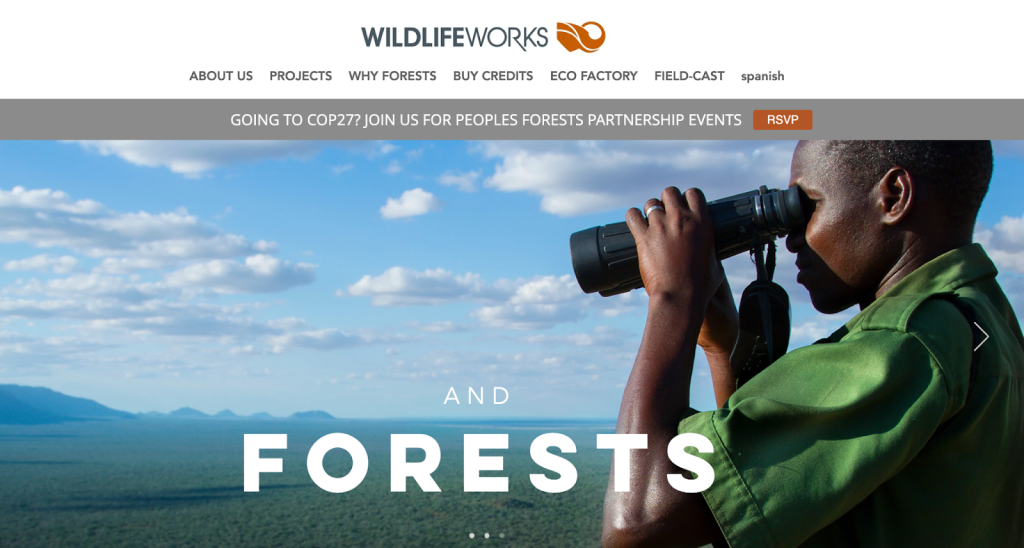
Wildlife Works was founded in 1997 by Mike Korchinsky to help communities transition from extraction-based to conservation-based livelihoods. Today, they develop and manage REDD+ projects in Kenya, Cambodia, and Colombia to combat deforestation and create sustainable livelihoods.
“Biodiversity-driven. Community-centered. Ecosystem-based.”
Wildlife Works
Project overview: Wildlife Works has developed the Kasigau Corridor, Mai Ndombe, and Southern Cardamom REDD+ projects in Kenya, Cambodia, and Colombia, respectively. Altogether, they protect over 2.4 million acres of rainforest and create jobs and other livelihoods other than poaching and deforestation.
Carbon offset effectiveness: The Kasigau Corridor project is verified by the CCBS at gold level, the Mai Ndombe project is verified by Verra, and the Southern Cardamom project is verified by Verra and the CCBS at gold level. Each of the 3 projects also adheres to multiple UN Sustainable Development Goals.
Carbon offset costs: Carbon offsets cost approximately $20 per ton of CO2.
How to get your carbon offsets: You can visit Wildlife Works’ webpage to view their REDD+ projects and purchase your carbon credits.
The Ocean Foundation: A Community Foundation for the Ocean
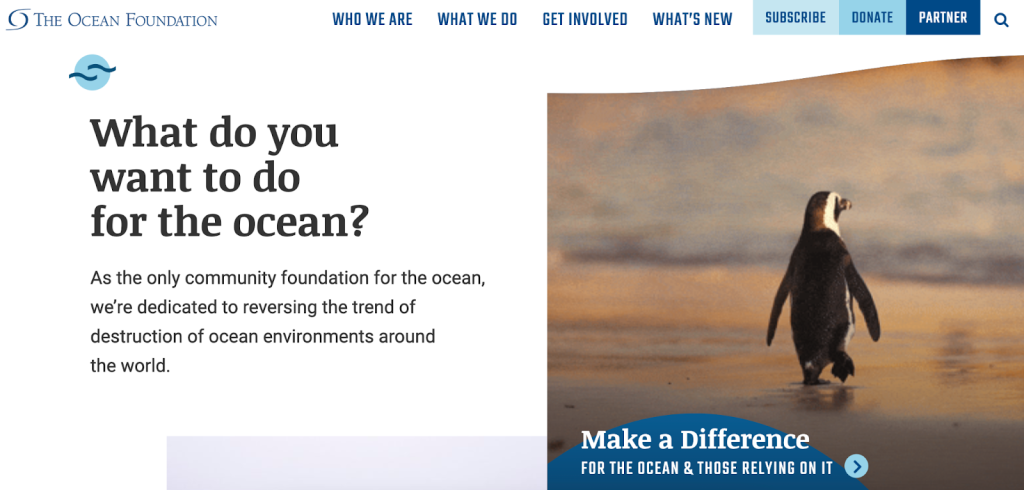
The Ocean Foundation was founded by Wolcott Henry in 2003 as a community foundation committed to reversing ocean degradation globally. Today, they protect our oceans and coastal ecosystems through conservation initiatives, community foundation services, research and development, and blue carbon offsets.
“Our focus is the ocean. And our community is every one of us who depends upon her.”
The Ocean Foundation
Project overview: The Ocean Foundation has a carbon calculator for flights, households, and businesses as well as a direct carbon offset. Purchases support the planting of seagrass. Seagrass meadows are an important carbon sink and store 11% of the ocean’s buried carbon despite accounting for only 0.1% of the world’s seafloor.
Carbon offset effectiveness: Their seagrass carbon offsets are certified by the Verified Carbon Standard.
Carbon offset costs: It costs $20 per 1,000kg of CO2 offset.
How to get your carbon offsets: You can visit their website to get your blue carbon offsets.
South Pole: Providing the Tools to Achieve a Low-Carbon Reality
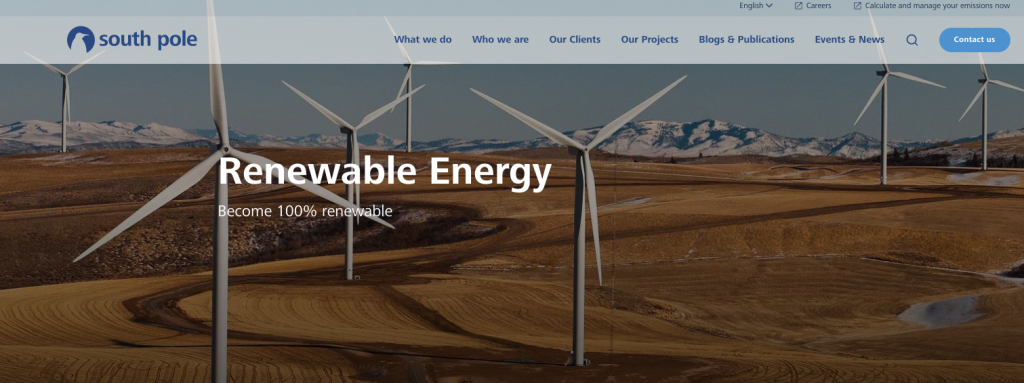
South Pole was founded in 2006 by 5 graduate students from the Swiss Federal Institute of Technology (ETH) as a platform to confront climate change. Today, they offer a wide variety of climate solutions including carbon offsets, environmental credits, and renewable energy credits (RECs).
“From ambition to action”
South Pole
Carbon offset overview: South Pole has a portfolio of over 700 verified carbon offset projects involving energy efficiency, biodiversity, clean water, and renewable energy. Examples of energy-efficiency projects include WWF Nature Clean Cookstoves in China, Bamako Clean Cookstoves in Mali, and Efficient Cookstoves in Rwanda.
Carbon offset effectiveness: South Pole’s carbon offset projects are certified by either the Verified Carbon Standard, Gold Standard, American Carbon Registry, or Climate Action Reserve. They are also aligned with the Paris Agreement and the United Nations Sustainable Development Goals.
Carbon offset costs: Costs are determined after initial contact.
How to get your carbon offsets: You can visit South Pole’s website and contact a representative to get your energy-efficiency carbon offsets.
GreenTech: Plastic Waste Conversion
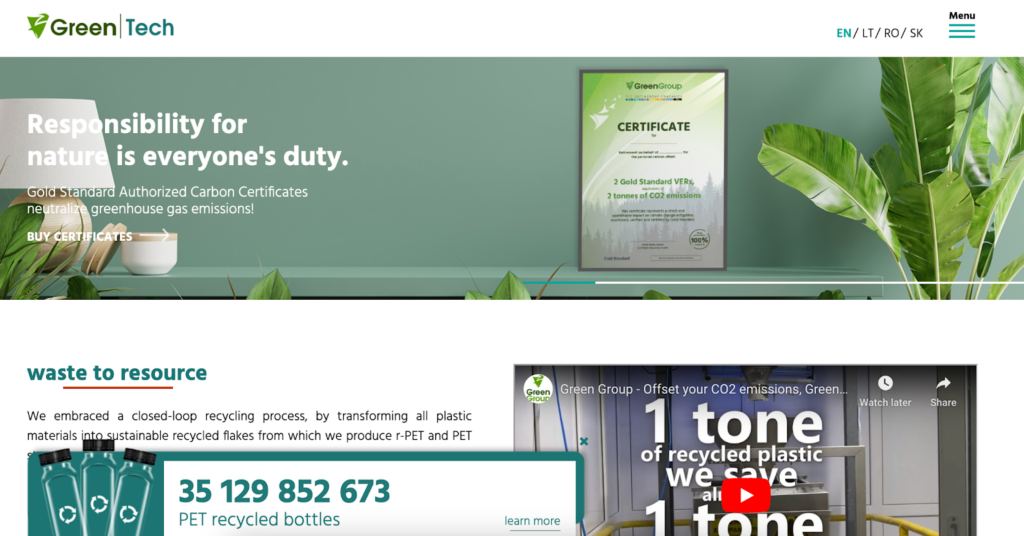
GreenTech was founded in 2002 as an offshoot of GreenGroup, Europe’s largest integrated recycling park. Today, they recycle over 100,000 tons of plastic per year, helping to reduce CO2 emissions and improve the lives of the communities they serve.
“Responsibility for nature is everyone’s duty”
GreenTech
Carbon offset overview: GreenTech is the first European recycling company to be endorsed by the Gold Standard for their issuance of polyethylene terephthalate (PET) recycling carbon credits. They take plastic (e.g., plastic bottles) and sort, grind, wash, and process it into sustainable recycled flakes to make products (e.g., PET flakes, PET straps, and r-PET granules). This results in up to 60% less CO2 emissions compared to manufacturing products from virgin inputs.
Carbon offset effectiveness: GreenTech’s offsets are certified by the Gold Standard and adhere to multiple UN Sustainable Development Goals.
Carbon offset costs: It costs approximately $40 per 1,000kg of CO2 offset.
How to get your carbon offsets: You can visit their website to purchase your waste management carbon offsets.
Vi Agroforestry: Tropical Agroforestry
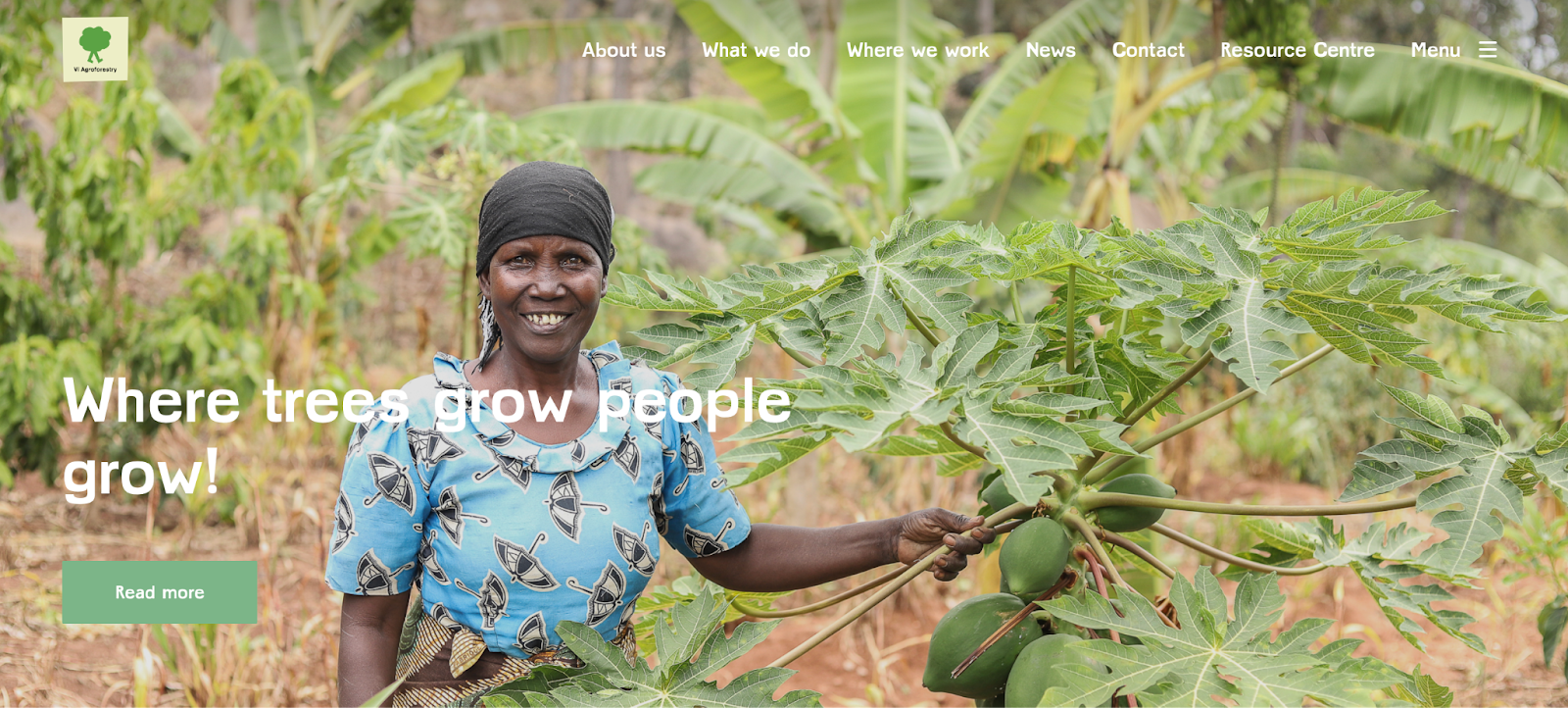
Vi Agroforestry is a Swedish development organization founded in 1983 initially as a tree planting organization. Today, they work with local partners in East Africa to provide agricultural development projects aimed at improving livelihoods.
“For climate and people, now.”
Vi Agroforestry
Project overview: Vi Agroforestry specializes in poverty reduction and environmental improvement through agroforestry and improved farming practices. They currently operate in Kenya, Rwanda, Tanzania, and Uganda. Their Kenya Agriculture Carbon Project (KACP) is the first soil and agricultural carbon project in Africa, which helps 30,000 farmers battle food security and combat climate change. Carbon credits generated from the project benefit small-holder farmers.
Carbon offset effectiveness: The KACP is certified by the Verified Carbon Standard.
Carbon offset costs: It costs approximately $28 per 1,000kg of CO2 offset.
How to get your carbon offsets: You can visit their website to calculate your carbon footprint and get your carbon offsets.
Carbofex: Converting Waste Biomass Into Biochar
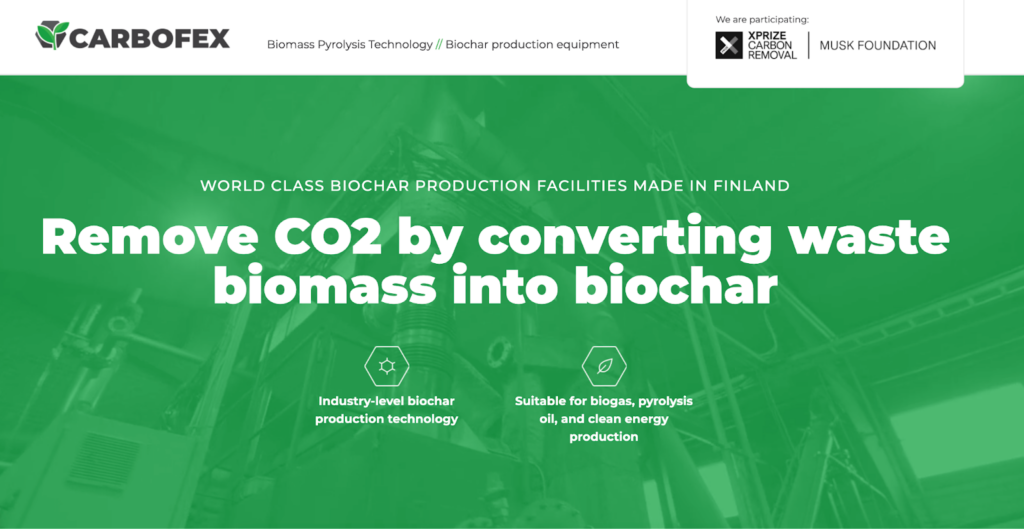
Carbofex is a Finnish biochar company founded in 2016 by Sampo Tukiainen and Veikko Kantero to lower atmospheric CO2 levels long term. Today, they have captured almost 10 million kg of CO2, which equals the carbon footprint of over 2,000 average citizens.
“Unique, state-of-art, turnkey solution for biochar and bio-energy co-production”
Carbofex
Project overview: Carbofex’s pyrolysis technology takes waste biomass from urban or agricultural sources and turns it into biochar, which can then be used to enhance agricultural soils or produce renewable energy. Through this process, Carbofex generates carbon credits certified that are then sold through the Puro.earth trading platform. Each kg of biochar they produce is capable of binding approximately 3.5 kg (7.7 lbs) of CO2 to the soil.
Carbon offset effectiveness: Carbofex’s process complies with the European Biochar Consortium (EBC) standard. And to be listed on Puro.earth, Carbofex also had to undergo third-party independent verifiers who audit carbon removal project facilities and issue CO2 Removal Certificates (CORCs).
Carbon offset costs: Carbofex uses resellers to sell their solutions. Visit the Puro.earth website to learn more about their respective pricing.
How to get your carbon offsets: You can get your Husk biochar carbon offsets through the Puro.earth website.
Carbonfund: Forestry, Energy Efficiency, and Waste Management Offsets
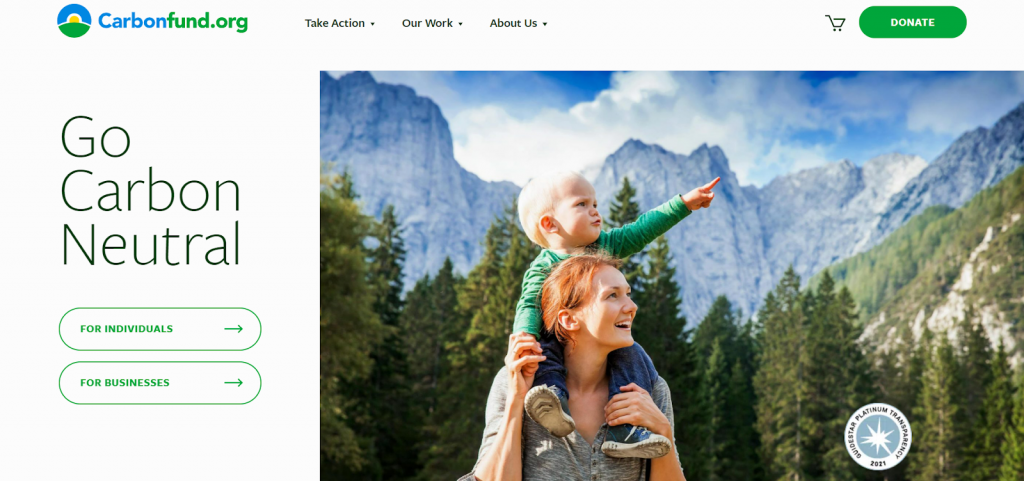
Carbonfund was founded in 2003 by Eric Carlson to make it easy for any individual, business, or organization to reduce and offset their climate impact. Today, they have been incorporated into ClimeCo and provide verified energy efficiency, renewable energy, and forestry carbon offsets for individuals and businesses.
“Reduce what you can, offset what you can’t.”
Carbonfund
Carbon offset overview: Carbonfund supports a variety of carbon offset projects including:
- Reforestation: Lower Mississippi Alluvial Valley Reforestation Initiative and Panama Reforestation Project
- Energy Efficiency: The Kenya Burn Stoves Project, Aqua Clara Water Filtration Programme, South Korea Waste Energy Co-Generation Project, and Truck Stop Electrification projects
- Waste Management: The New Bedford Landfill gas-to-renewable energy and Seneca Meadows landfill projects
Carbon offset effectiveness: Carbonfund uses the Verified Carbon Standard, Gold Standard, American Carbon Registry, and Climate Action Reserve to help ensure transparency and quality in the creation, quantification, and verification of offset projects.
Carbon offset costs: Individual carbon offsets range from $16.25-$17.16 per 1,000kg of CO2, small business carbon offsets range from $390-$1,560 per year (dependent on the number of employees), and large business carbon offset costs are evaluated after personal contact.
How to get your carbon offsets: You can visit their website to purchase your individual or business carbon avoidance offsets.
Terrapass: A Variety of Carbon Offsets for Individuals and Businesses
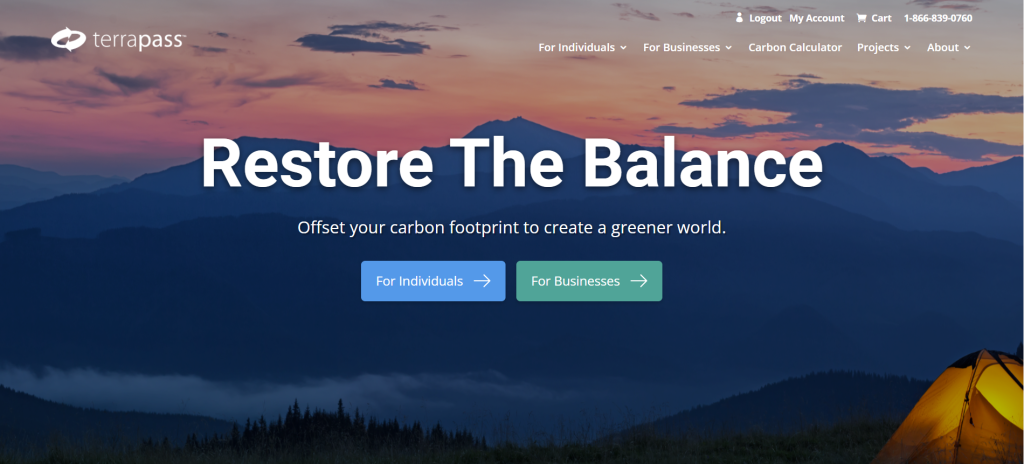
Terrapass was founded in 2004 by Dr. Karl Ulrich to reduce as many carbon emissions as possible via the use of education, online tools, carbon offsets, and renewable energy. Today, they provide verified carbon offsets and renewable energy credits for renewable energy, landfill gas capture, and forestry projects.
“Restore the balance.”
Terrapass
Carbon offset overview: Terrapass supports a variety of carbon offset projects including:
- Reforestation/Afforestation: Québec Afforestation/Reforestation project
- REDD+: Cordillera Azul National Park REDD+ Project, NIHT Topaiyo REDD+ Project
- Blue Carbon: Katingan Peatland Restoration and Conservation Project
- Waste Management: Henrico County Landfill Gas Combustion Project and A-Gas Voluntary Emission Reduction Project
- Agriculture: Holsum Elm Dairy, Cottonwood Dairy Organic Waste Digestion Project, Scenic View Dairies, and George DeRuyter and Sons Dairy projects
Carbon offset effectiveness: Terrapass only purchases carbon offsets that have been generated within the last 5 years, and they use the Verified Carbon Standard, Gold Standard, American Carbon Registry, and the Climate Action Reserve to help ensure transparency and quality in the creation, quantification, and verification of offset projects.
Carbon offset costs: It costs approximately $16.51-$17.63 per 1,000kg of CO2 for individuals, and $16.99 per 1,000kg of CO2 for businesses.
How to get your carbon offsets: You can visit their website to purchase your carbon offsets.
How Effective and Efficient Are Carbon Offsets
In terms of effectiveness, carbon offsets can reduce CH4 emissions, reinforce our terrestrial and marine carbon sinks, and promote energy independence. However, they can also have varying levels of permanence, lack additionality, and may not reduce carbon emissions immediately, depending on the type of offset. Lastly, they do not reduce your own carbon emissions, which could lead to greenwashing.
In terms of efficiency, carbon offsets can preserve existing forests and marine ecosystems, continue to avoid CO2 emissions after project lifespans, and have low rates of carbon re-emission. However, they can also have varying levels of costs, may face carbon storage capacity limitations, and can be difficult to monitor and verify, depending on the type of offset. In general, carbon offsets are not yet scaled to compensate for our global emissions.
Carbon offsets are effective at mitigating climate change because:
- Offsets involving waste management and agriculture can reduce methane (CH4) emissions.
- Offsets involving reforestation, afforestation, REDD+, and agriculture reinforce forests, which are one of our largest carbon sinks.
- Offsets involving blue carbon reinforce coastal and marine ecosystems, which are one of our largest carbon sinks.
- Offsets involving energy efficiency can help reduce reliance on fossil fuels, leading to increased energy security and energy independence.
However, carbon offsets can also lack effectiveness because:
- The permanence of carbon offsets depends on whether it is a technology-based or nature-based solution.
- Offsets involving energy efficiency and waste management often lack additionality because many projects receiving revenue now would have been built regardless.
- Carbon offsets may not reduce carbon emissions immediately, depending on the type of offset.
Carbon offsets are efficient at reducing CO2 emissions because they:
- Offsets involving REDD+ and blue carbon can efficiently protect existing forests and marine ecosystems.
- Offsets involving reforestation, afforestation, and blue carbon offsets can continue to reduce carbon long after projects have been completed.
- Offsets involving direct carbon/air capture (DCC/DAC) and carbon mineralization are permanent solutions with low rates of CO2 re-emission.
However, carbon offsets can also lack efficiency because:
- Carbon offsets have varying levels of costs, depending if it is a technology or nature-based offset.
- Reforestation, afforestation, and some blue carbon and agricultural offsets are all limited by trees’ carbon storage capacity.
- Energy efficiency, blue carbon, and agricultural carbon offsets can be difficult to standardize, verify, and monitor.
- Carbon offsets are not yet at a scale where they can compensate for our global carbon emissions.
In addition, carbon offsets do not reduce your own carbon emissions, which can lead to greenwashing. This occurs when emissions are only offset and not reduced from the source, and the consumer is deceived into thinking they are offsetting their emissions but in reality, they are not. This is why we should first reduce our emissions before relying on offsets.
What Are The 8 Pros and 8 Cons of Carbon Offsets
Depending on the type, carbon offsets can permanently and quickly reduce CO2 and CH4 emissions. They also can be cost-effective, promote energy independence, reinforce our terrestrial and marine carbon sinks, and help offset carbon emissions that can’t be reduced otherwise.
Depending on the type, carbon offsets can lack permanence or additionality, be expensive or difficult to monitor and verify, and are not yet scaled to compensate for our global emissions. They also can face carbon storage capacity limitations, do not reduce emissions immediately, and do not reduce your own carbon emissions, which can lead to greenwashing.
Related: Are you interested in learning more about the pros and cons of carbon offsets? Check out the full article here: “Carbon Offsets: All 8 Pros and 8 Cons Explained”
What Are the 8 Pros of Carbon Offsets
Carbon offsets have various pros that make them effective at reducing carbon emissions.
| 8 Pros of Carbon Offsets | Quick Facts |
| #1: Carbon offsets can be permanent | Carbon offsets involving direct carbon/air capture (DCC/DAC), carbon mineralization, waste management, and agriculture can permanently remove carbon from the atmosphere with low rates of carbon re-emission. |
| #2: Carbon offsets can reduce CO2 emissions quickly | Carbon offsets involving direct carbon/air capture (DCC/DAC), carbon mineralization, energy efficiency, and some waste management and agricultural practices can reduce emissions immediately. |
| #3: Carbon offsets can reduce methane (CH4) emissions | Carbon offsets involving waste management and agriculture can reduce methane (CH4) emissions. |
| #4: Carbon offsets can be cost-effective | Carbon offsets involving reforestation, afforestation, agriculture, energy efficiency, waste management, REDD+, and blue carbon are some of the most cost-effective methods of carbon emission reduction. |
| #5: Carbon offsets can promote energy decentralization, bolster energy security, and help transition away from fossil fuels | Carbon offsets involving energy efficiency can help reduce reliance on fossil fuels, leading to increased energy security and energy independence. |
| #6: Carbon offsets can reinforce our terrestrial carbon sinks | Carbon offsets involving reforestation, afforestation, REDD+, and agriculture reinforce forests, which are one of our largest carbon sinks. |
| #7: Carbon offsets can reinforce our marine carbon sinks | Carbon offsets involving blue carbon reinforce coastal and marine ecosystems, which are one of our largest carbon sinks. |
| #8: Carbon offsets allow us to reduce carbon emissions in ways we wouldn’t be able to accomplish individually | Carbon offsets allow us to reduce emissions from activities where sustainable alternatives are not yet widely available. |
What Are the 8 Cons of Carbon Offsets
Understanding the drawbacks of carbon offsets is important in order to effectively mitigate climate change
| 8 Cons of Carbon Offsets | Quick Facts |
| #1: Carbon offsets can lack permanence | Carbon offsets involving reforestation, afforestation, REDD+, blue carbon, and agriculture often lack permanence because they are reversible solutions. |
| #2: Carbon offsets can lack additionality | Carbon offsets involving REDD+ often lack additionality because what would have happened without REDD+ intervention cannot be measured exactly. |
| #3: Carbon offsets can be expensive | Carbon offsets involving direct carbon/air capture (DCC/DAC) and carbon mineralization offsets are some of the most expensive methods of carbon removal. |
| #4: Carbon offsets are not yet at a scale where they can compensate for our global carbon emissions | Carbon offsets are not yet scaled to compensate for the billions of tons of GHG we emit annually. |
| #5: Carbon offsets can be difficult to monitor and verify | Energy-efficiency, blue carbon, and agricultural carbon offsets can be difficult to standardize, verify, and monitor. |
| #6: Carbon offsets can face carbon storage capacity limitations | Carbon storage capacity limitations prevent reforestation, afforestation, blue carbon, and agroforestry efforts from being scalable enough to compensate for all of our carbon emissions. |
| #7: Carbon offsets may not reduce carbon emissions immediately | Reforestation, afforestation, blue carbon, and agricultural offsets may not reduce carbon emissions immediately because of the time needed to plant trees and for them to reach maturity. |
| #8: Carbon offsets do not reduce your own carbon emissions, which can lead to greenwashing | Carbon offsets do not reduce your own carbon emissions, which can lead to greenwashing. |
How Can Carbon Offsets Help Mitigate Climate Change
Climate change is a severe and long-term consequence of fossil fuel combustion. Carbon offsets that are additional and permanent can help mitigate climate change because they reduce emissions from activities where sustainable alternatives are not yet widely available. If left untreated, atmospheric carbon can remain there for tens of thousands of years and exacerbate the negative effects of climate change.
How is Climate Change Defined
Climate change is arguably the most severe, long-term global impact of fossil fuel combustion. Every year, approximately 33 billion tons (bt) of CO2 are emitted from burning fossil fuels. The carbon found in fossil fuels reacts with oxygen in the air to produce CO2.
“Climate change: changes in the earth’s weather, including changes in temperature, wind patterns, and rainfall, especially the increase in the temperature of the earth’s atmosphere that is caused by the increase of particular gasses, especially carbon dioxide.”
Oxford Dictionary
Atmospheric CO2 fuels climate change, which results in global warming. When CO2 and other air pollutants absorb sunlight and solar radiation in the atmosphere, they trap the heat and act as an insulator for the planet. Since the Industrial Revolution, Earth’s temperature has risen a little more than 1 degree Celsius (C), or 2 degrees Fahrenheit (F). Between 1880-1980 the global temperature rose by 0.07C every 10 years. This rate has more than doubled since 1981, with a current global annual temperature rise of 0.18C, or 0.32F, for every 10 years.
As outlined in the 2015 Paris Climate Agreement, we must cut current GHG emissions by 50% by 2030 and reach net zero by 2050.
How Do Carbon Offsets Generally Help Mitigate Climate Change
Levels of carbon in our atmosphere that cause climate change have increased as a result of human emissions since the beginning of the Industrial Revolution in 1750. The global average concentration of carbon dioxide in the atmosphere today registers at over 400 parts per million. Carbon offsets can help prevent these levels from increasing even more.
When you hear the words “carbon offset”, think about the term “compensation”. Essentially, carbon offsets are reductions in GHG emissions that are used to compensate for emissions occurring elsewhere.
Carbon offsets that meet key criteria and verified project standards, are additional and permanent, and are part of projects that are carried out until the end of their lifespan have the best chance of reducing carbon emissions and therefore reducing climate change.
When we offset CO2 we also slow the rate of global temperature rise, which in turn minimizes the effects of climate change.
How Do Carbon Offsets Specifically Help Mitigate Climate Change
Direct carbon/air capture and carbon mineralization offsets specifically help mitigate climate change because these methods permanently lock away CO2 for thousands of years with little to no carbon re-emission.
Reforestation, afforestation, and REDD+ offsets specifically help mitigate climate change because they plant more trees, and trees remove CO2 from the air as they grow. By increasing the number of trees on our planet, we increase the amount of carbon they are capable of storing. The more carbon our forests can sequester, the less carbon there is in our atmosphere.
Blue carbon offsets specifically help mitigate climate change because they protect coastal and marine ecosystems, which are capable of absorbing more CO2 per acre than rainforests and at a rate 10x greater.
Energy-efficiency offsets involving clean cookstoves, water filtration programs, and co-generation facilities specifically help mitigate climate change by reducing CO2 emissions from direct fossil fuel combustion and indirect electricity generation. By using energy-efficient appliances and methodologies, we reduce the amount of CO2 entering our atmosphere.
Waste management offsets involving landfill gas capture/combustion, landfill gas to renewable energy, biodigesters, biogas, and composting specifically help mitigate climate change because they capture emissions from waste, turn it into renewable energy, and reduce the overall amount of waste.
Agricultural offsets including biochar, agroforestry, avoided grassland conversion, and CH4 capture can specifically help mitigate climate change because they reduce CO2 and CH4 emissions in one of the biggest industries worldwide.
Final Thoughts
The best carbon offset projects involve practices such as direct carbon/air (DCC/DAC), carbon mineralization, reforestation, afforestation, REDD+, blue carbon, energy efficiency, waste management, or agriculture. The best projects are also additional – meaning that they reduce carbon emissions more than would have occurred without them – and permanent.
For all of the good carbon offsets can instigate, they should not be seen as the only solution to climate change. They are effective at reducing CO2 in the short term, but in the long term, they fail to reduce CO2 enough.
When used in conjunction with direct CO2 reduction measures, carbon offsetting can be much more effective. We should reduce our own carbon footprint as much as possible first, and only then choose the most effective carbon offsets.
Stay impactful,

Stay impactful,

Sources
- United Nations Framework Convention on Climate Change: The Paris Agreement
- Britannica: Carbon Offset
- David Suzuki Foundation: Are carbon offsets the answer to climate-altering flights?
- South Pole: Carbon Offsets Explained
- Impactful Ninja: What Are Direct Carbon Capture Offsets and How Do They Work
- Impactful Ninja: What Are Carbon Mineralization Offsets and How Do They Work
- Impactful Ninja: What Are Tree Planting Carbon Offsets and How Do They Work
- Impactful Ninja: What Are Afforestation Carbon Offsets and How Do They Work
- Impactful Ninja: What Are REDD+ Carbon Offsets and How Do They Work
- Impactful Ninja: What Are Blue Carbon Offsets and How Do They Work
- Impactful Ninja: What Are Energy Efficiency Carbon Offsets and How Do They Work
- Impactful Ninja: What Are Waste Management Carbon Offsets and How Do They Work
- Impactful Ninja: What Are Agriculture Carbon Offsets and How Do They Work
- Impactful Ninja: Why Is a Carbon Footprint Bad for the Environment?
- Britannica: Carbon Footprint
- Impactful Ninja: What Are Nature-Based Carbon Offsets and How Do They Work? The Big Picture
- Gold Standard: Homepage
- American Carbon Registry: Homepage
- Plan Vivo: Homepage
- Verified Carbon Standard: Homepage
- Climate Action Reserve: Homepage
- American Carbon Registry: Homepage
- The Climate, Community and Biodiversity Standards: Homepage
- Climeworks: Homepage
- Climeworks: Fight climate change by removing CO2 from the air
- Climeworks: Direct air capture to help reverse climate change
- Climeworks: Orca
- Climeworks: Mammoth
- Climeworks: Subscriptions
- Climeworks: Choose the gift of carbon removal
- Neustark: Homepage
- Neustark: Remove
- The Arbor Day Foundation: Homepage
- The Arbor Day Foundation: About
- The Arbor Day Foundation: Carbon Offset Donation
- United Nations Department of Economic and Social Affairs: The 17 Goals
- REDD.plus: Homepage
- Coalition for Rainforest Nations: Homepage
- United Nations Framework Convention on Climate Change: Info Hub – REDD+
- Xpansiv: Homepage
- REDD.plus: Corporations
- REDD.plus: Individuals
- SeaTrees: Homepage
- Sustainable Surf: Homepage
- SeaTrees: About Us
- SeaTrees: Projects
- SeaTrees: SeaTrees FAQ
- Eden Reforestation Projects: Homepage
- Impactful Ninja: 9 Best Charities for Reforestation
- DelAgua: Homepage
- DelAgua: Project Rwanda
- DelAgua: Carbon Credits
- United Nations Convention Framework on Climate Change: The Paris Agreement
- United Nations Department of Economic and Social Affairs: The 17 Goals
- CoreZero: Homepage
- LinkedIn: CoreZero – About
- CoreZero: Contact Us
- Husk: Homepage
- Husk: About Us
- Husk: Biochar
- Husk: CFB
- Husk: ONIX P9
- European Biochar: C-Sink
- Patch: Homepage
- greenSand: Homepage
- greenSand: Permanent CO2 Compensation
- greenSand: All Products
- greenSand: We are greenSand
- greenSand: Operation of Olivine Stone
- greenSand: Certificate – CO2 Compensation
- Open Natural Carbon Removal Accounting: Homepage
- Ecologi: Homepage
- Ecologi: Reforestation and Carbon Offsetting Projects
- Ecologi: restoring degraded land in Senegal
- Ecologi: forest plantation on degraded grassland in Uruguay
- Ecologi: mangrove planting at Kandrany Madagascar
- Ecologi: reforestation in Mozambique
- Ecologi: protecting and restoring Andean forests in Bolivia
- Ecologi: Saving endemic Moroccoan fruit tree species
- One Tree Planted: Homepage
- Trees for the Future: Homepage
- Ecologi: Ecologi Public Impact & Operations Ledger
- Ecologi: Your Plan
- One Tree Planted: About us
- One Tree Planted: Where We Plant
- One Tree Planted: Plant Trees in California
- One Tree Planted: Plant Trees in Romania
- One Tree Planted: AFR100 – Plant Trees for Africa
- One Tree Planted: Plant Trees in Iceland
- One Tree Planted: Carbon Offset
- Wildlife Works: Homepage
- Wildlife Works: History
- Wildlife Works: Wildlife Works REDD+ Projects Around the World
- Wildlife Works: Wildlife Works Kasigau Corridor Kenya REDD+ Project
- Wildlife Works: Mai Ndombe Wildlife Works REDD+ Developer
- Wildlife Works: Cambodia S. Cardamoms
- Wildlife Works: Wildlife Works and the Sustainable Development Goals
- Wildlife Works: Buy Credits
- The Ocean Foundation: Homepage
- The Ocean Foundation: About the Ocean Foundation
- The Ocean Foundation: Calculator
- The Ocean Foundation: Why Go Blue?
- The Ocean Foundation: Donate to Seagrasss Grow
- South Pole: Homepage
- South Pole: WWF Clean Cookstoves
- South Pole: Bamako Clean Cookstoves
- South Pole: Efficient Cookstoves
- South Pole: Climate Action Projects
- South Pole: South Pole has developed over 700 climate action projects
- South Pole: Contact the Team
- GreenTech: Homepage
- GreenGroup: Homepage
- GreenTech: Reducing CO2
- United Nations Department of Economic and Social Affairs: The 17 Goals
- GreenTech: Gift Certificates
- Vi Agroforestry: Homepage
- Vi Agroforestry: Kenya Agriculture Carbon Project (KACP)
- Vi Agroforestry: The Climate Calculator
- Carbofex: Homepage
- Puro.earth: Homepage
- European Biochar: The European Biochar Certificate
- Puro.earth: Biochar – Finland
- Carbonfund: About Carbonfund.org
- Carbonfund: Our Forestry/Reforestation Projects
- Carbonfund: Lower Mississippi Alluvial Valley Reforestation Initiative
- Carbonfund: Panama Tropical Reforestation Project
- Carbonfund: Kenya Burn Stoves Project
- Carbonfund: Aqua Clara Water Filtration Programme
- Carbonfund: South Korea Waste Energy Co-Generation Project
- Carbonfund: Truck Stop Electrification Project
- Carbonfund: New Bedford Landfill Gas-to-Energy Project
- Carbonfund: The Seneca Meadows Landfill Project
- Carbonfund: For Individuals – Offset Your Carbon Footprint
- Carbonfund: Become a Small Business Partner
- Carbonfund: Become a Large Business Partner
- Carbonfund: Carbonfree® Partner Programs for businesses
- Terrapass: Homepage
- Terrapass: About Terrapass
- Terrapass: Projects
- Terrapass: Québec Afforestation/Reforestation
- Terrapass: Cordillera Azul National Park REDD+
- Terrapass: NIHT Topaiyo REDD+ Project
- Terrapass: Katingan Peatland Restoration and Conservation Project
- Terrapass: Henrico County Landfill Gas Combustion Project
- Terrapass: A-Gas Voluntary Emission Reduction Project
- Terrapass: Holsum Elm Dairy
- Terrapass: Cottonwood Dairy Organic Waste Digestion Project
- Terrapass: Scenic View Dairies
- Terrapass: George DeRuyter and Sons Dairy
- Terrapass: Solutions for Individuals
- Terrapass: Solutions for Businesses
- Britannica: Methane
- Client Earth: What is a Carbon Sink?
- Impactful Ninja: What is the Carbon Footprint of Fossil Fuels?
- International Energy Administration: Energy Security
- US Environmental Protection Agency: Summary of the Energy Independence and Security Act of 2007
- Carbon Offset Guide: Permanence
- Carbon Offset Guide: Additionality
- EcoTree: How much CO2 does a tree absorb?
- Yale Environment 360: Is the ‘Legacy’ Carbon Credit Market a Climate Plus or Just Hype?
- Edie: Carbon offsetting – How are businesses avoiding greenwashing on the road to net-zero?
- Impactful Ninja: How Effective and Efficient Are Carbon Offsets? Here Are the Facts
- Impactful Ninja: Carbon Offsets: All 8 Pros and 8 Cons Explained
- World Nuclear Association: Carbon Emissions from Electricity
- Natural Resources Defense Council: Global Warming 101
- myclimate: What does “net zero emissions” mean?
- Natural Resources Defense Council: Carbon Offsets 101
- Terrapass: Carbon Offset Projects
- United Nations Framework Convention on Climate Change: Paris Climate Agreement
- The Ocean Foundation: Reduce Your Carbon Footprint
- Energy Information Administration: Renewable Energy Explained
- Energy Star: Compact Fluorescent Light Bulbs (CFLs) and Mercury
- Our World in Data: Where in the world do people have the highest CO2 emissions from flying?
- Zero Waste Europe: Reusable vs Single Use Packaging
- Carbonbrief: Interactive – What is the climate impact of eating meat and dairy?
- Stop Waste: Recycling and Climate Protection
- Impactful Ninja: Is Taking Long Showers Bad for the Environment?
- United States Environmental Protection Agency: Showerheads
- Impactful Ninja: 4 Main Reasons Why Reducing Your Carbon Footprint is Important
